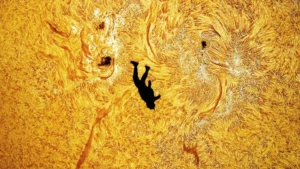In the summer of 1950, four men sat down for lunch together at Los Alamos. It was, at the time, the center of American physics, and these men were respected contributors to their field. Among them was Enrico Fermi, a giant in the fields of quantum mechanics and thermodynamics.
But the men were relaxing over lunch, and the conversation was not erudite. Nuclear physicist Emil Konopinski brought up a cartoon he had recently seen in The New Yorker, explaining why public trash cans were disappearing from the streets of New York City. The cartoon showed what was evidently a flying saucer with little green men filing toward it with the spirited-away trash cans.
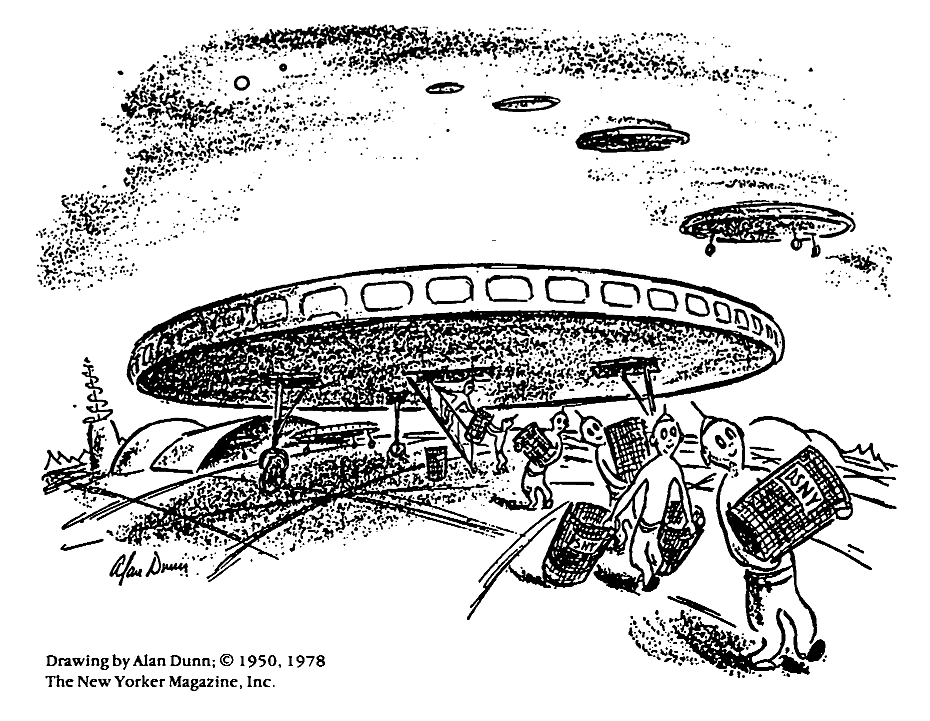
The cartoon discussed by the group at Los Alamos. Photo: Alan Dunn/New Yorker
Well, Fermi pointed out, this was a very logical hypothesis. It explained both the regularity of UFO sightings and the strange disappearance of New York trash cans.
The group laughed and moved on. They finished lunch. Then, out of nowhere, Fermi exclaimed, “But where is everybody?”
He was talking about extraterrestrial life, and everyone at the table knew it. They tossed about some ideas but largely treated the matter as a joke.
“As far as our galaxy is concerned, we are living somewhere in the sticks, far removed from the metropolitan area of the galactic center,” said physicist Edward Teller.
But the question stuck. It became known as Fermi’s Paradox: if the Earth isn’t special, and the Universe is so very big with so many stars, where is everybody?

Los Alamos in 1944, during the Manhattan Project. Photo: LANL Atomic Heritage
The search for alien life begins
A decade passed. The Cold War kicked into high gear, driving scientific competition. Radio astronomy historian Rebecca Charbonneau told ExplorersWeb that the Cold War’s technological advances spurred the search for extraterrestrial life.
“The launch of Sputnik in 1957 and the subsequent proliferation of artificial satellites — including early signals-intelligence platforms — made detecting non-human technosignatures suddenly plausible,” she explained.
The thought of aliens began to captivate a fringe group of astronomers, notably Frank Drake. He convened a meeting on the subject at the National Radio Astronomy Observatory site in Green Bank, West Virginia.
“Drake had invited everyone he could think of with an interest in the scientific search for E.T. — all 12 of them — to the meeting,” wrote Nadia Drake, his daughter.
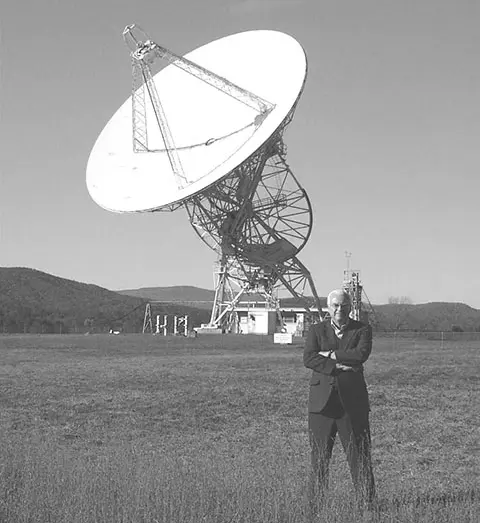
A famous photograph of Frank Drake in front of the Tatel 85-foot telescope at Green Bank Observatory. Recreating this photo is not advised, as the author can attest. Nowadays, the field in which he stood is overgrown and full of ticks. Photo: NRAO/GBO
The Drake Equation
In order to guide the discussion, Frank Drake sat down and estimated the number of civilizations in the galaxy with whom Earth could communicate. It was a very simple estimation. The number of civilizations would be equal to the rate of star formation, times the fraction of stars with planets, times the number of habitable planets per solar system, times the fraction of habitable planets that actually lead to life, times the fraction of life-bearing planets with intelligent life, times the fraction of intelligent civilizations that develop a means to communicate in outer space, times how long those civilizations actually release signals.
At the time, astronomers had begun to understand the rate of star formation in the Milky Way. Everything else in the equation was a complete mystery.
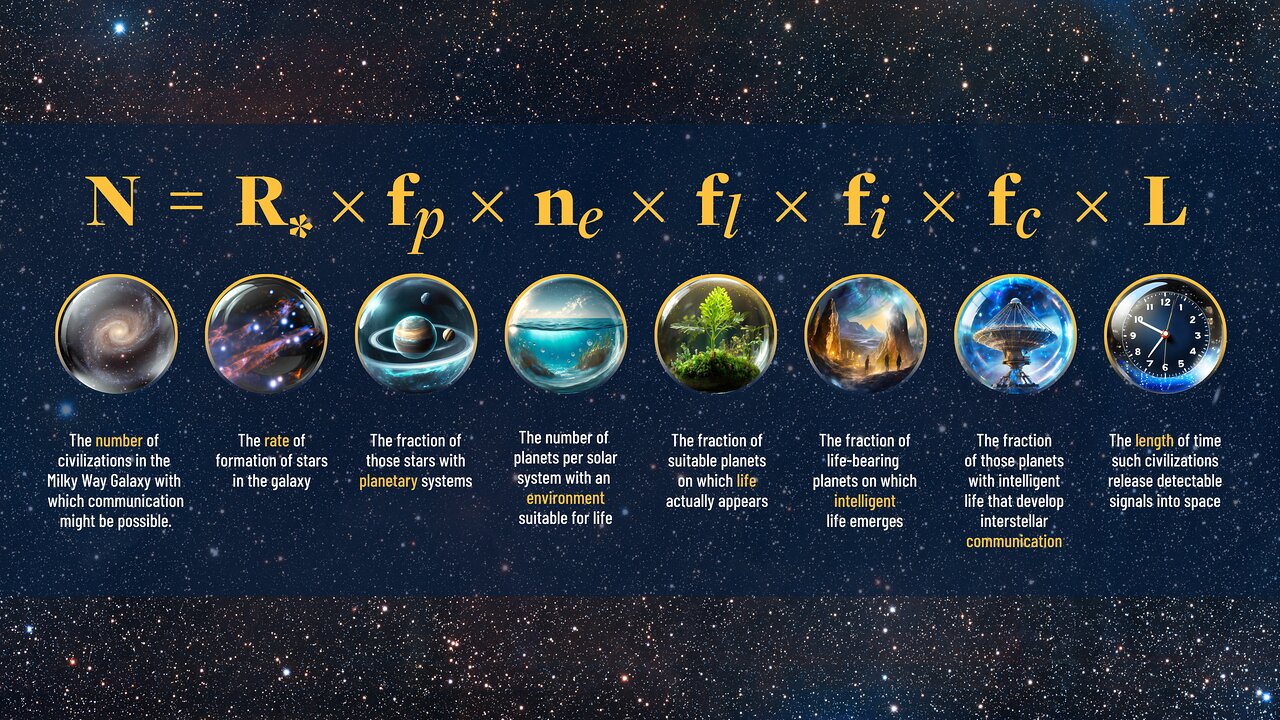
When Drake formulated his equation, almost all the factors were totally unknown. Nowadays, we have much better estimates. Photo: NOIRLab/AURA/NSF/P. Marenfeld
When Drake formulated his estimate, astronomers had no confirmation that planets even existed around other stars. All logic suggested they would, but they were far too faint to detect with contemporary telescopes. So the field theorized, argued, and waited.
Astronomers took another two decades to confirm that extrasolar planets, or exoplanets, existed. That confirmation didn’t come from any of the famous modern methods of exoplanet detection, such as light fluctuations or watching a star wobble back and forth. Instead, it came from a previous candidate for extraterrestrial communication: the strange dead stars known as pulsars.
Little Green Man 1
The discovery of pulsars dates back to 1967 when graduate student Jocelyn Bell Burnell noticed a strange repeating radio signal in her telescope data. She had no idea what to make of it and dubbed it “Little Green Man 1.”

This image of Jocelyn Bell Burnell’s radio observations of the first pulsar became the iconic album cover for Joy Division’s ‘Unknown Pleasures.’ Photo: Peter Saville
Unfortunately for the little green men, it eventually became clear that the signal came from a rapidly rotating object known as a neutron star. Neutron stars are incredibly dense and incredibly small, with a mass greater than that of the Sun but a radius the size of San Francisco. Every time they spin around, their off-kilter magnetic fields fling out regular radio emissions.
Jocelyn Bell Burnell had discovered the first example of one of the most exotic objects in the known Universe. (The Nobel Prize, of course, went to her advisor.)
The study of pulsars blossomed into a flourishing subfield. In general, pulsars are near-perfect clocks. While different pulsars have different periods, every radio pulse arrives at the Earth perfectly on time.
Not so for the pulsar that Aleksander Wolszczan and Dale Frail observed in 1992. The arrival time of each pulse wobbled up and down: now just before expected, now just after.
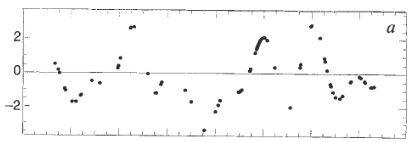
This plot, included in the initial discovery paper, shows the wobble in the pulse times of arrival. The y axis is the difference between the expected arrival time and the actual arrival time, measured in milliseconds. The x axis is the year of observation. Photo: A. Wolszczan & D. A. Frail
First step: finding exoplanets
Wolszczan and Frail tried modeling the noise as a companion star to the pulsar. It didn’t work. Every time they succeeded in getting rid of one part of the wobble, another part stepped forward to dominate.
They began thinking outside the box. The best solution was for not one but two companions to the pulsar: planets just a little bit more massive than the Earth. The varying pulse time of arrival came from the pulsar moving back and forth very slightly in its orbit such that each pulse had to travel a subtly different distance to reach the Earth.
Exoplanets existed. Grappling with the first two terms in the Drake Equation was suddenly far more tractable. Onto the next step: How many of the planetary systems out there had habitable planets?
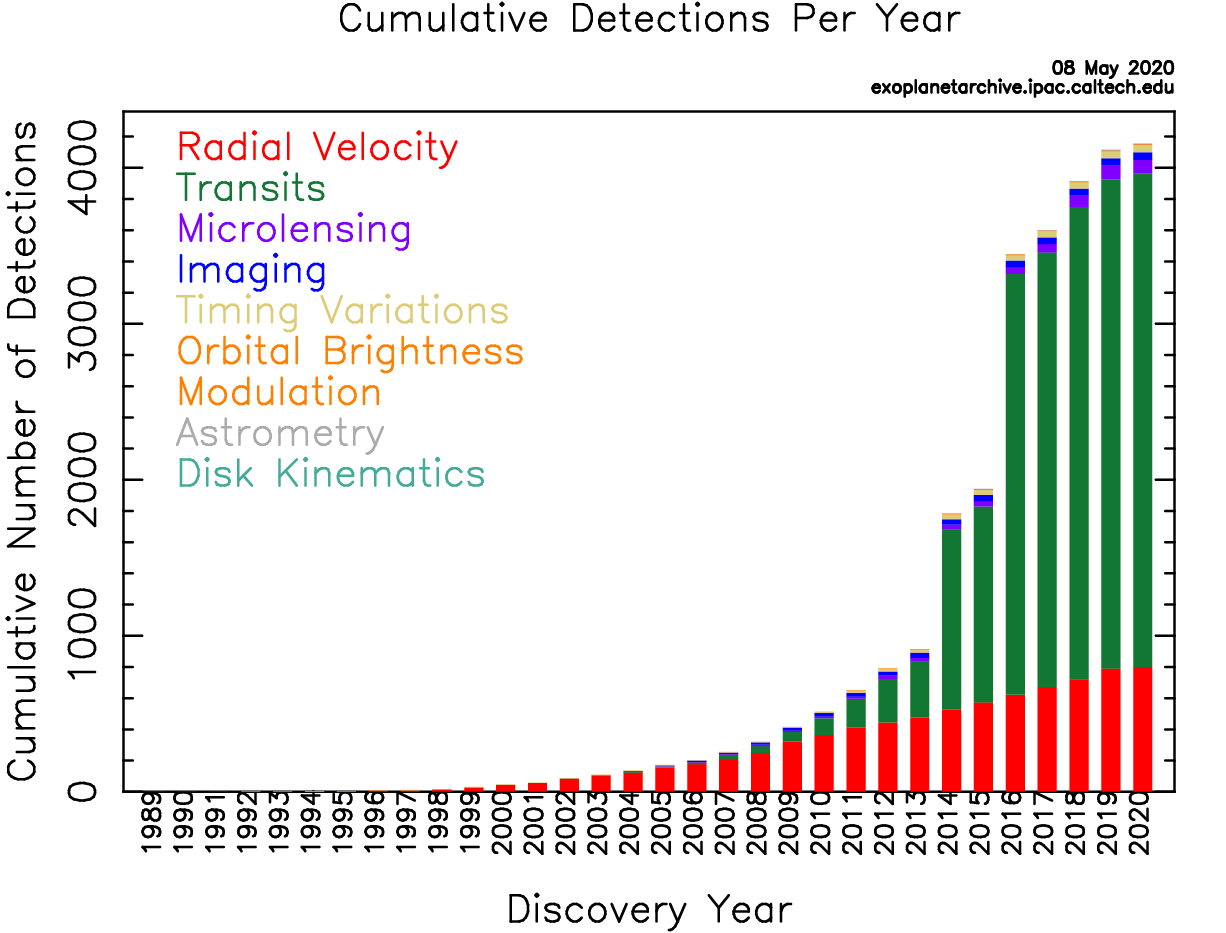
The number of new exoplanets has blossomed with improved telescope technology. Photo: NASA Exoplanet Archive
Exoplanets were no longer the domain of the theorists. As the 21st century rolled ahead, new high-sensitivity telescopes allowed the detection of exoplanets around all kinds of stars. Today, we know of almost 6,000.
It took until 2014 for the Kepler satellite telescope to detect anything that looked like Earth. The first such exoplanet is the memorably named Kepler-186f, an Earth-sized planet orbiting at a habitable distance from a red dwarf star. The atmosphere and climate of Kepler-186f differs dramatically from that of Earth, but it’s not a stretch to imagine other lifeforms might thrive there.

An artist’s impression of Kepler-186f. Photo: NASA Ames/SETI Institute/JPL-Caltech
Nowadays, terrestrial-style exoplanets are so numerous that they comprise an entire subfield. The NASA Exoplanet Encyclopedia tracks all of them, including their mass and how habitable they seem. Statistics of exoplanet habitability are no longer a mystery.
So where’s the life?
When Drake formulated his equation in 1961, astronomers had only pinned a value on the first term. Now, the first three are well-understood and understood to be high. In short, there are a lot of stars out there, a lot of those stars have planets, and a lot of those planets are habitable. So where’s the life?
For the fourth term (the regularity with which life emerges on habitable planets), astronomers must turn to theoretical estimates by paleobiologists and geochemists. For the fifth (the fraction of intelligent life), evolutionary biologists. The sixth and seventh terms are the realm of theorists doing work that is important but so fringe that they don’t have a field to call their own.
The fact remains that, as far as we know, we have never been contacted by any extraterrestrial species. So one of those terms must be exceedingly low, or else something stranger is going on.
Possible answers
Perhaps the simplest way to answer the Fermi Paradox is that life rarely forms in the universe. With the fourth term in the Drake Equation close to zero, humans could expect never to get a call from any nearby neighbors. The nearest extraterrestrial life might be across the Milky Way or in another galaxy entirely. This was the interpretation favored by paleobiologist Stephen J. Gould.
Other biologists posit that the fifth term is the blockade. In this scenario, life abounds nearby, but we’re the smartest kids on the block. Astrobiologist Charles Lineweaver points out, “Dolphins have had about 20 million years to build a radio telescope and have not done so.”
It’s also possible that the sixth term is practically zero. Other intelligent life might exist, but can’t communicate with us. Still on about dolphins, Lineweaver adds, “If you live underwater and have no hands, no matter how high your E.Q., you may not be able to build, or be interested in building, a radio telescope.”
Those three solutions posit a universe where humans are special. They are also the happiest possibilities. Another common hypothesis is that the seventh term in the Drake Equation — the length of time for which civilizations communicate — is very short because natural catastrophes regularly cause the extinction of intelligent life. Asteroids, gamma-ray bursts, and volcanoes are all potential culprits.
A darker theory
The darker version of that theory is that intelligent life inevitably eradicates itself through nuclear war, climate change, or other disasters. Carl Sagan argued that self-destruction was common, but civilizations that avoided it would endure for eons.
“Perhaps there is a waiting time before contact is considered appropriate,” he wrote, “so as to give us a fair opportunity to destroy ourselves first, if we are so inclined.”
The Dark Forest Theory, named after the book by science fiction writer Cixin Liu, posits that intelligent life wouldn’t destroy itself but others. Other science fiction writers such as Dennis Taylor have also flirted with this idea, painting a galaxy in which one species of alien has eradicated most other intelligent life. Stephen Webb suggested that since humans are superpredators, successful alien life would be as well.
It’s also possible intelligent alien life exists, but we can’t begin to comprehend it. It might not appear as life to us, or as intelligent. It might choose not to communicate for reasons that would baffle us. It might not want to leave its homeworld.
It might, in other words, be alien.






